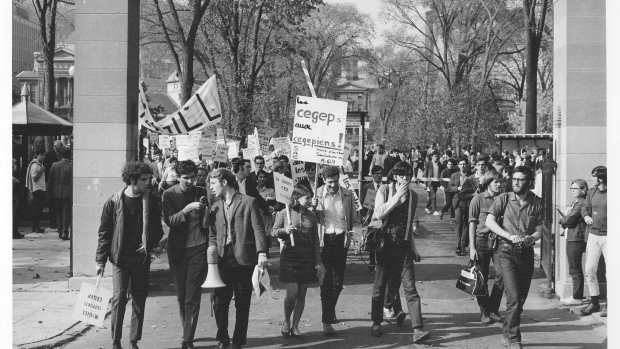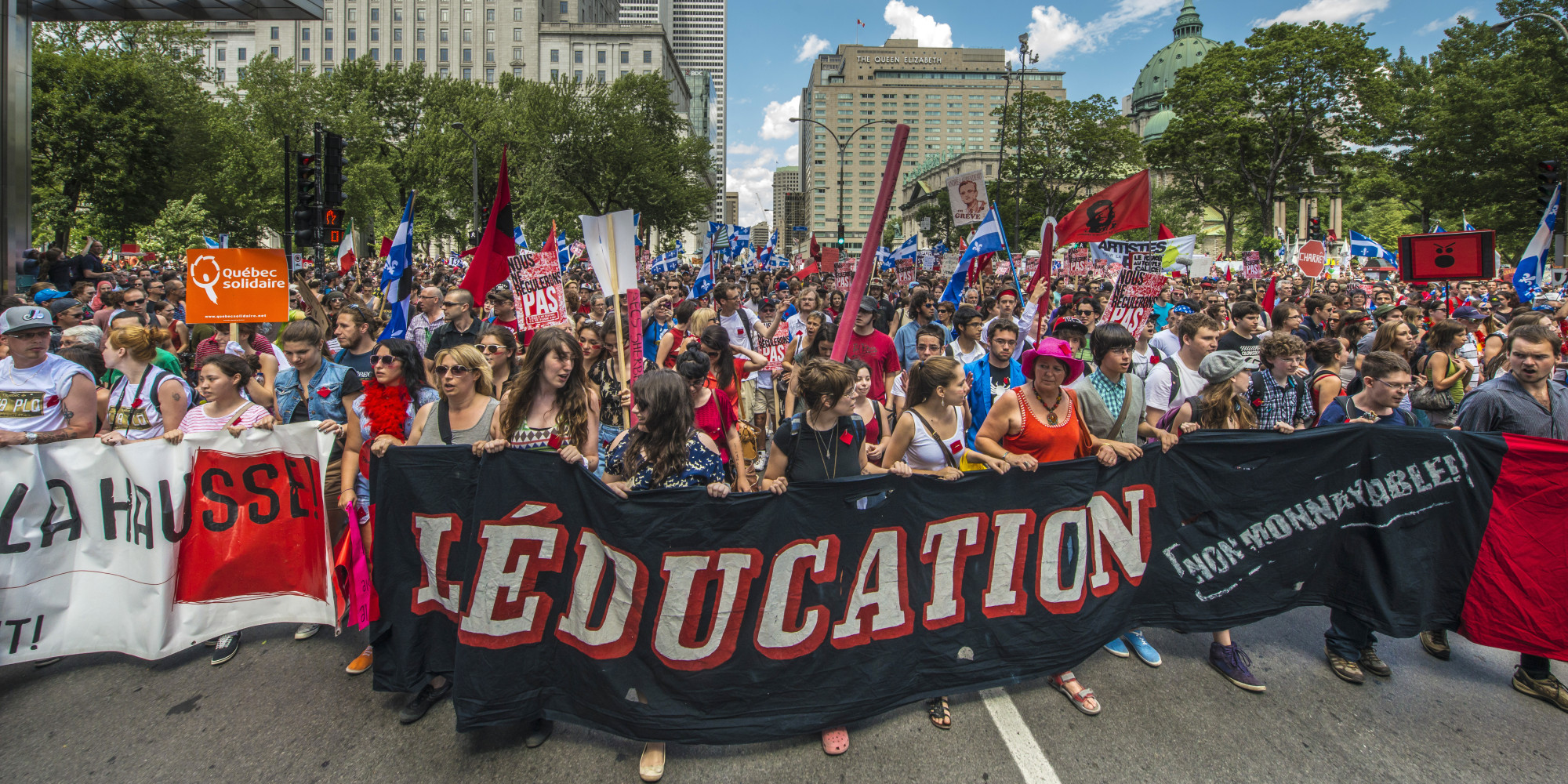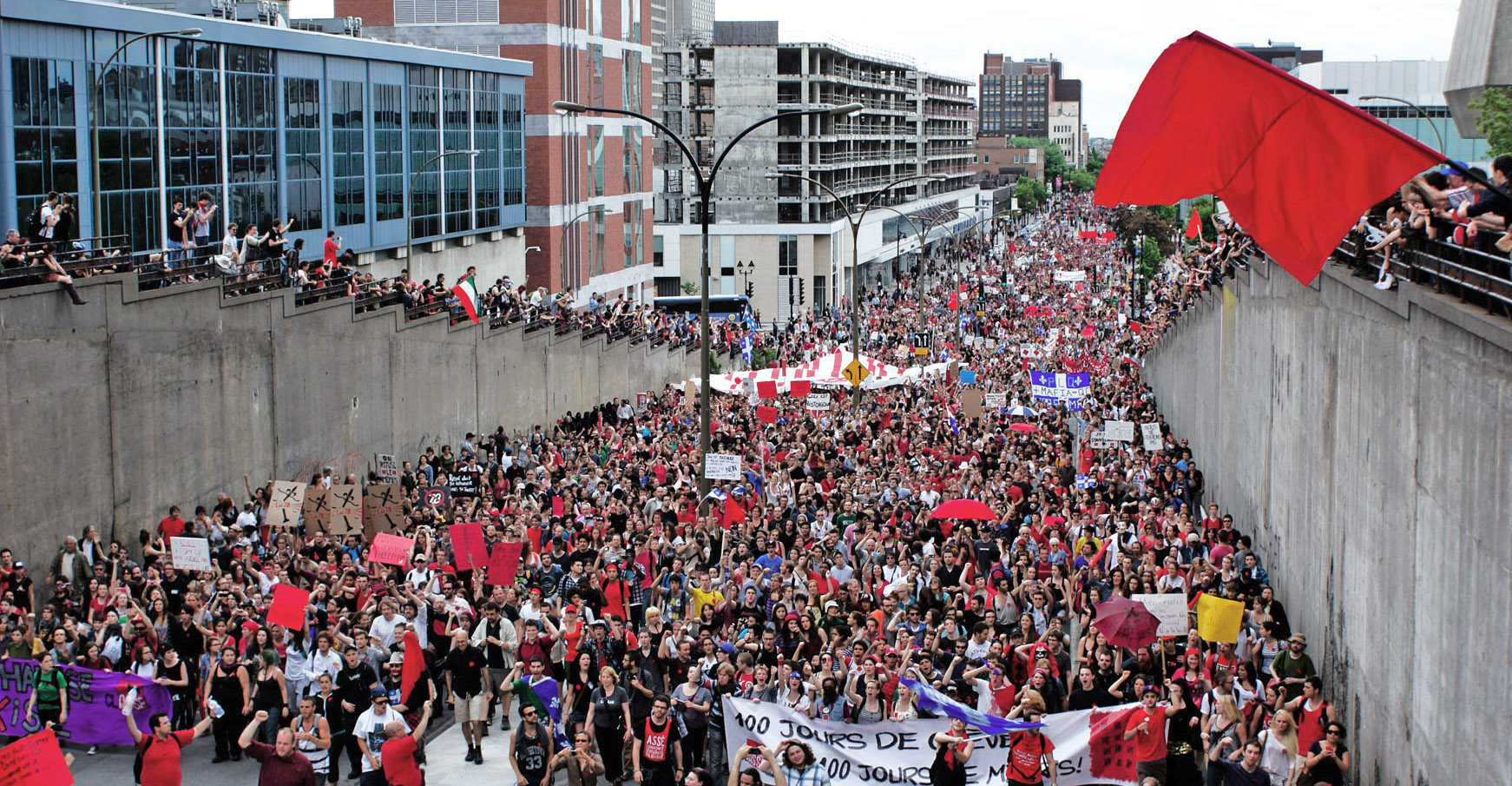Quebec’s student unions and federations are some of the most politically active and mobile student networks in the world. Since the first general student strike in 1968, national student federations have organized six more massive strikes in Quebec. Twenty-first century political activism in the province has largely become organized around the student associations of CEGEPs and universities, mobilized by national student federations. Although many of the unions and federations associated during the 2012 general strike—the latest in Quebec’s history—have disbanded, student unions and federations like the Students’ Society of McGill University (SSMU) continue to mobilize their members in smaller ways around a myriad of political issues. In the sociopolitical landscape of post-2012 Quebec, student unions have become the primary vehicles for political mobilization.
-
UGEC and FAGECCQ organize first student strike, called for creation of Université du Québec network.
1968
-
Independent unions strike to abolish entry level tests for francophone universities and improved financial aid.
1974
-
ANÉÉQ led strike to demanding improved financial aid.
1978
-
ANÉÉQ strike for freeze on tuition. Government later announced $1,100 tuition hike.
1986
-
FEUQ, FECQ, and MDE led strike to prevent tuition hikes from being enacted. Protests revealed divide between leftists and moderates.
1996
-
ASSÉ, FECQ, and FEUQ strike against transformation of $103 million in student grants to student loans.
2005
-
ASSÉ, FECQ, and FEUQ strike against $1,600 tuition hike. Mobilized over 250,000 students.
2012
In 1968, the General Union of Quebec Students (UGEC) and the Fédération des associations générales des étudiants des collèges classiques du Québec (FAGECCQ) organized the first general student strike in Quebec’s history. The protests successfully mobilized students from 15 out of 23 CEGEPs throughout the province. Protesters demanded better accessibility to postsecondary institutions for francophone and working-class students, a better understanding of governmental positions concerning loans and bursaries, and that university campuses be more democratic. Many students took to the streets to protest, and some even barricaded themselves in their schools, refusing to allow classes to continue until their demands were met. McGill’s Political Science Association (PSA, now the PSSA) demonstrated by boycotting all political science courses for two weeks and occupying the fourth floor of the Leacock building.
Many of the students’ demands were not met, and UGEC, their primary organizer, disbanded in the years that followed. Nevertheless, the 1968 student demonstrations did successfully pressure the provincial government. In the wake of the protests the government created the Université du Québec network, and established five new universities throughout the province, including Université du Québec à Montreal (UQÀM), the city’s second francophone university. The demonstrations also had one unanticipated consequence, which was not among the striking students’ list of demands: Jumpstarting a long history of student union-led protests in the province of Quebec.

Since 1968, student activism has become the primary method of direct political action in Quebec. In an interview with The McGill Tribune, Students’ Society of McGill University (SSMU) Vice-President (VP) External Connor Spencer explained how, in the decades following 1968, student unions and federations mobilized their members to challenge the government on both student and nonstudent issues.
“A lot of activism has always been centred [around university campuses],” Spencer said. “[There’s] this latest wave of activism that, I would argue, started in the 1950s. Before that [...] the majority of mobilization and activism was housed under labour unions. In the ‘50s, [mobilization] was largely led by the students. Then [in the late 1960s...] I think that’s truly when we can say that student associations, student movements, and student activism became 100 per cent related to each other.”
Although the student unions and federations disbanded in the years following 1968, students once again organized a general strike in 1974, this time aiming to abolish entry level tests for francophone universities, and to improve the province’s financial aid system. Capitalizing on the student networks that were created during the strike, student associations from 24 CEGEPs and five universities formed the Association Nationale des Étudiantes et des Étudiants du Québec (ANÉÉQ), one of the first national student associations in Quebec. The founding of ANÉÉQ reinforced the legacy of national associations’ involvement in student activism in Quebec. Members of ANÉÉQ participated in another student strike in 1978, and successfully pressured the government for even more concessions on student financial aid.
In 1986, ANÉÉQ led the fourth student general strike in Quebec’s history after rumours spread that the newly elected Liberal provincial government would reverse a freeze of university tuition in the province. The strike successfully extracted promises from the Liberal Party to maintain the freeze. However, in 1990, Robert Bourassa, premier at the time, announced annual tuition would be raised from $500 to $1,600 over a four-year period. Although ANÉÉQ mobilized students in reaction to the tuition hike, it failed to organize a general strike, and the tuition hike was not reversed.
In 1993, ANÉÉQ disbanded, but in its place appeared the Fédération étudiante collégiale du Québec (FECQ) and the Fédération étudiante universitaire du Québec (FEUQ). In 1996, after the announcement of another round of university tuition hikes, the FEUQ and the FECQ participated in a general student strike, this time organized by a new national student association, the Mouvement pour le droit à l'éducation (MDE). The strike was successful, and the tuition hikes were never enacted, but a divide between radicals and moderates in the student movement appeared. In an interview with the Tribune Isaac Stethem, Communications Coordinator at the Association for the Voice of Education in Quebec (AVEQ), explained the divide.
“Objectively, the FECQ and the FEUQ were not as far left-wing as ASSÉ, so obviously there are criticisms that come from the political positions taken,” Stethem said.
The FECQ and the FEUQ favoured direct negotiation with governments, and discouraged student strikes when possible, while the MDE was wary of negotiations. The MDE eventually disbanded in 2000 and was replaced by the Association pour une solidarité syndicale étudiante (ASSÉ), which continues to serve as the forum for leftist voices among Quebec’s national student associations.
The ASSÉ, FECQ, and FEUQ came together in 2005 when the Quebec government, facing severe budget cuts, decided to transform $103 million in student grants into student loans. First the ASSÉ decided to call for another general student strike in January, and then the FECQ, FEUQ, SSMU, and the McGill Post-Graduate Students’ Society (PGSS) followed suit in March. However, while the ASSÉ continued its strike, the FEUQ and FECQ reached a settlement with the government in April.
Stethem described leftist criticisms of the FECQ and FEUQ during the 2005 protests, and how the resulting division continues to characterize Quebec student movements to this day.
“There was very serious criticism after [the 2005 protests] that, basically, they had split the student movement,” Stethem said. “[...] In any large mobilization, these kinds of [divisions] always come into it. [When there are] literally hundreds of thousands of people taking part in [a] movement, [there will be] tensions in terms of different perspectives, in terms of who is being presented as public faces of the movement, and in terms of media interviews.”

Many of the FEUQ’s members—including SSMU, one of its largest—were unhappy with the FEUQ’s decision to exclude ASSÉ from negotiations, and left the federation in response. In 2012, however, the FEUQ, FECQ, and ASSÉ once again collaborated to organize the longest general student strike in Quebec’s history. After proposals by the Liberal government to increase tuition by over $1,600 between the years of 2012 and 2018, the three student federations organized a general student strike that lasted multiple months and drew over 250,000 students from across the province. The strike included a protest in Montreal on it’s 100th day that many cite as the single largest act of civil disobedience in Canadian history, with over 400,000 participants. Stethem explained how in 2012, unlike during the 2005 strike, FECQ, FEUQ, and ASSÉ were able to collaborate successfully.
“There has definitely been criticism of the role the FECQ and the FEUQ played [in the 2012 protests],” Stethem said. “Some people would say they co-opted it a bit, that they weren’t interested in mobilizing around it at the beginning, and that it was ASSÉ and local, independent associations that were [mobilizing] and that [FECQ and FEUQ only] later took on a role. The contrast though, in terms of the role [FECQ and FEUQ] played, [is that] obviously, if you have a big mobilization like that, federations [will] play a role in terms of mobilizing people, organizing events, and being public spokespeople.”
Stethem identified this difference as one of the keys to the movement’s outcome.
“One of the biggest things that’ll happen is, at a certain point, [students] are asked to negotiate with the government to try to come to a settlement,” Stethem said. “The big difference [between 2005 and 2012] is that in 2012, part of what did allow the mobilization to go on for so long was that the three student federations did actually respect working in solidarity. They all required each other’s presence in order to speak with the government, and worked together on that to a great degree.”
The 2012 protests ended when, during the Fall semester, a Parti Québécois government was elected and enacted a tuition freeze, appeasing the demands of the striking student federations. The 2012 protests were the latest general student strike in Quebec, and the last major episode in the student movement. Spencer explained how, following the protests, student activism has become the principal method of direct action in Quebec.
“Looking from 2012 onwards, [...] if you want something done, you go to the students and get them to sign on,” Spencer said. “When folks have an initiative or are trying to lobby the government for something, they go to students, and they try to get the support of the students.”
Although there has not been a general strike since 2012, student associations and unions throughout the province have continued to mobilize in smaller ways. At McGill, SSMU has rallied around a number of issues, during both periods of student unrest and of inactivity.
“Like a lot of universities, SSMU actively campaigned against the South African apartheid [in the 1980s],” Spencer said. “Something folks don’t realize is that Demilitarize McGill has been a campaign that has come about in waves. It has actually been around since the ‘80s. Tied to that have been demonstrations against nuclear war. Recently we’ve seen a lot of mobilization from SSMU around pipelines, and the construction of pipelines in Canada. We’re very slowly starting to see mobilization around Indigenous rights. Largely, that’s been mediated [by] discussions of climate justice, and I think that’s one thing that moving forward SSMU has [to work on].”
On Oct. 12, SSMU’s Legislative Council passed a Motion to Endorse the Popular Demonstration Against Racism and the Far-Right on Nov. 12. The motion gives Spencer the mandate to hold two workshops on the far right and to mobilize a contingent of SSMU members to attend the Popular Demonstration Against Racism and the Far-Right.
“[The workshops will cover] information and awareness about what the far right looks like when it’s organizing on our campuses,” Spencer said. “The first workshop will [address] what the far right is, how we identify it, and the second workshop is focused more on the specific Quebec context and the rise of the far right in our immediate region, and how it's been mobilizing.”
AVEQ, a national student federation that SSMU is an observing member of, has a number of different political issues it mobilizes around. In an interview with the Tribune, AVEQ Coordinator of Education and Research, Sophia Sahrane listed some of their campaigns.
“One way [AVEQ] contributes [to political activism] is by producing research,” Sahrane said. “We are mandated by our members to approach certain issues, and often, so that we can have ammunition and facts to back up our arguments, we produce research. We have the action fund, where people can apply for funding for direct action, campaigns, and any kind of project that stands within our values and positions. Kristin Perry, who is our Coordinator of Mobilization and Associative Development, facilitates a lot of meetings [...] and puts people in contact [to] further help with mobilization.”
Both SSMU and AVEQ will mobilize its members for the Popular Demonstration Against Racism and the Far-Right on Nov. 12. Quebec’s student unions have, by and large, become the main avenue through which demonstration organizers source members to mobilize. The participation of a student union or national federation can be the deciding factor for whether a demonstration successfully lobbies the government, and few large protests in Quebec are carried out without some degree of student union support or solidarity.
“All issues are inherently political and social issues,” Sahrane said. “When we’re talking about human rights, when we’re talking about student rights, when we’re talking about abuse, racism, transphobia, homophobia, everything boils down to politics. As a student union representing a diversity of students, and having our positions and our values and the different things that we stand for, I think that it’s honourable to give a voice to the people that are most marginalized.”

